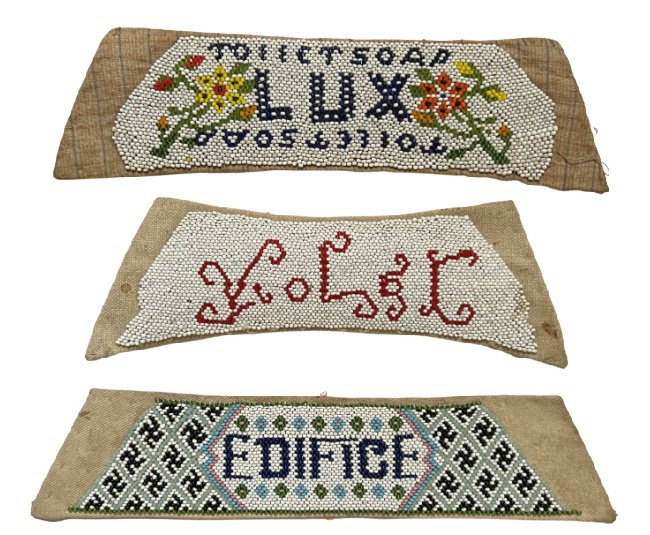
The Pearl Carpet of Baroda
An estimated 1.5 million Basra pearls were used to make the Pearl Carpet of Baroda in 1865, along with rubies, emeralds, sapphired and diamonds, plus Venetian glass seed beads.

Zulu Square Beaded Ropes
A lavishly illustrated blog post on Zulu Square Beaded Rope Necklaces by Valerie Hector. Learn about this Zulu beading technique - and how to bead it yourself.

Zulu Beaded Sangoma Headdresses
Among the Zulu people of South Africa, traditional healers and diviners were known as sangoma. To symbolize their profession, sangoma had beads braided into their hair - or wore beaded bigs. This beautifully illustrated article explores the topic in depth.

Joyce J. Scott’s New traveling Exhibition
Mobilia Gallery has curated a new traveling exhibition of Joyce J. Scott’s work in 2023-2024. A full-color catalog will accompany the show, to be published by Arnoldsche.

chinese beaded slipper panels Inscribed with Western Motifs
A brief appreciation of mainland Chinese bead-embroidered slipper or sandal panels.

The charms of the chinese firecracker Box
A brief appreciation of a minor Chinese folk art from ca. 1900.

An Antique Japanese Glass Bead Curtain - and Some Comparable Chinese Examples
A glass bead curtain found in Japan features motifs and inscriptions similar to those found on glass bead curtains in China.

Appreciating Japanese (?) Metalwork
Small, decorative metal plaques, probably made in Japan, feature motifs drawn from the natural world.

The Lattices at Yin Yu Tang - and Possible Parallels in Mainland Chinese Beadwork
Valerie visits Yin Yu Tang, a Chinese house preserved at the Peabody Essex Museum in Salem, MA.

Inventing Bead Polyhedra
Chinese beaders of centuries past gave the world a fantastic invention: by rendering geometric structures in beads. In this article, beading historian Valerie Hector discusses an early example of such a Chinese beaded bead made during the Qing dynasty (1644-1911).
king tut’s game-changing beadwork
King Tut owned game-changing beadwork! Beaded sandals and other objects found in his tomb prove that by ca. 1330 BC, four game-changing advances had taken place - liberating all beaders to come.

who invented three-dimensional peyote stitch?
There was a time when flat or two-dimensional peyote stitch was all anyone knew. Until ca. 1800 BC, that is, when the ancient Egyptians invented three-dimensional peyote stitch, a game-changing advance..

When did Bead Netting Begin?
When did bead netting begin? Probably, in ancient Egypt by about 2400 BC. In this article, beadwork historian Valerie Hector shows an ancient beaded dress featuring two ancient beading techniques: ladder stitch and open diamond netting. The ancient Egyptians not only used both techniques in a single piece - they mastered the art of bead contouring, shaping the dress in figure-flattering ways.

How did ancient bead stringers keep their bead strands aligned?
How did ancient bead stringers align strands of beads? With spacer plates made of carved bone or pure gold. In this article, beadwork historian Valerie Hector shows an example of spacer plate stringing in a man’s beaded girdle dating to ca. 4000 BC in ancient Egypt - a girdle now housed in the British Museum.

Embedding Beads In a Textile Structure
What techniques were beaders using in 20,000 BC? Beadwork historian Valerie Hector investigates a man’s densely beaded hat, found in a cave along ancient Italy’s Ligurian coast. The hat was heavily encrusted with sea shell beads. What beading technique was used to connect them - bead netting, bead plaiting, or something else?

Quantum Leaps in the Field of Beadwork since ca. 30,000 BCE
Valerie begins a series of posts devoted to major advances in the field of beadwork that she thinks of as “quantum leaps” or game-changing advances. Quantum Leap #1 might well be the development of bead embroidery. The earliest surviving evidence - from ca. 26,000 BC - was found at an archaeological site in Sungir, a town not far from Moscow. Beading historian Valerie Hector discusses this amazing find.

Decoding an Anomalous Gujarati Chakla
Valerie writes of an unusual piece of ca. 1930s-1940s beadwork from Gujarat State, India.

"Tangerines"
Valerie Hector reviews "Tangerines," a movie set in rural Abkhazia in the early 1990s, when civil war is erupting, leaving enmity - and beauty - in its wake. A fine movie, well worth seeing.

